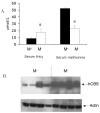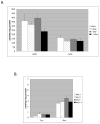Methionine-deficient diet induces post-transcriptional downregulation of cystathionine β-synthase
- PMID: 20036517
- PMCID: PMC2956870
- DOI: 10.1016/j.nut.2009.10.006
Methionine-deficient diet induces post-transcriptional downregulation of cystathionine β-synthase
Abstract
Objective: Elevated plasma total homocysteine (tHcy) is a risk factor for a variety of human diseases. Homocysteine is formed from methionine and has two primary metabolic fates: remethylation to form methionine or commitment to the transsulfuration pathway by the action of cystathionine β-synthase (CBS). We have examined the metabolic response in mice of a shift from a methionine-replete to a methionine-free diet.
Methods and results: We found that shifting 3-mo-old C57BL6 mice to a methionine-free diet caused a transient increase in tHcy and an increase in the tHcy/methionine ratio. Because CBS is a key regulator of tHcy, we examined CBS protein levels and found that within 3 d on the methionine-deficient diet, animals had a 50% reduction in the levels of liver CBS protein and enzyme activity. Examination of CBS mRNA and studies of transgenic animals that express CBS from a heterologous promoter indicated that this reduction is occurring post-transcriptionally. Loss of CBS protein was unrelated to intracellular levels of S-adenosylmethionine, a known regulator of CBS activity and stability.
Conclusion: Our results imply that methionine deprivation induces a metabolic state in which methionine is effectively conserved in tissue by shutdown of the transsulfuration pathway by an S-adenosylmethionine-independent mechanism that signals a rapid downregulation of CBS protein.
Copyright © 2010 Elsevier Inc. All rights reserved.
Figures






Similar articles
-
Taurine-deficient diet up-regulated cystathionine beta-synthase monoallele in hemizygous cystathionine beta-synthase knockout mice.Nutr Res. 2009 Nov;29(11):794-801. doi: 10.1016/j.nutres.2009.10.005. Nutr Res. 2009. PMID: 19932868
-
Testosterone regulation of renal cystathionine beta-synthase: implications for sex-dependent differences in plasma homocysteine levels.Am J Physiol Renal Physiol. 2007 Aug;293(2):F594-600. doi: 10.1152/ajprenal.00171.2007. Epub 2007 May 30. Am J Physiol Renal Physiol. 2007. PMID: 17537983
-
Endothelial dysfunction and elevation of S-adenosylhomocysteine in cystathionine beta-synthase-deficient mice.Circ Res. 2001 Jun 8;88(11):1203-9. doi: 10.1161/hh1101.092180. Circ Res. 2001. PMID: 11397788
-
The effect of dietary modulation of sulfur amino acids on cystathionine β synthase-deficient mice.Ann N Y Acad Sci. 2016 Jan;1363(1):80-90. doi: 10.1111/nyas.12967. Epub 2015 Nov 24. Ann N Y Acad Sci. 2016. PMID: 26599618 Free PMC article. Review.
-
Lean Body Mass Harbors Sensing Mechanisms that Allow Safeguarding of Methionine Homeostasis.Nutrients. 2017 Sep 20;9(9):1035. doi: 10.3390/nu9091035. Nutrients. 2017. PMID: 28930162 Free PMC article. Review.
Cited by
-
Altered dietary methionine differentially impacts glutathione and methionine metabolism in long-living growth hormone-deficient Ames dwarf and wild-type mice.Longev Healthspan. 2014 Dec 15;3(1):10. doi: 10.1186/2046-2395-3-10. eCollection 2014. Longev Healthspan. 2014. PMID: 25584190 Free PMC article.
-
Cystathionine β-synthase deficiency: Of mice and men.Mol Genet Metab. 2017 Jul;121(3):199-205. doi: 10.1016/j.ymgme.2017.05.011. Epub 2017 May 19. Mol Genet Metab. 2017. PMID: 28583326 Free PMC article. Review.
-
Applying the indicator amino acid oxidation technique in the domestic cat: results of a pilot study and development of a non-steady state prediction model.J Anim Sci. 2023 Jan 3;101:skac390. doi: 10.1093/jas/skac390. J Anim Sci. 2023. PMID: 36434784 Free PMC article.
-
Long-term functional correction of cystathionine β-synthase deficiency in mice by adeno-associated viral gene therapy.J Inherit Metab Dis. 2021 Nov;44(6):1382-1392. doi: 10.1002/jimd.12437. Epub 2021 Oct 11. J Inherit Metab Dis. 2021. PMID: 34528713 Free PMC article.
-
Integrated metabolome and microbiome analysis reveals the effect of rumen-protected sulfur-containing amino acids on the meat quality of Tibetan sheep meat.Front Microbiol. 2024 Feb 8;15:1345388. doi: 10.3389/fmicb.2024.1345388. eCollection 2024. Front Microbiol. 2024. PMID: 38389537 Free PMC article.
References
-
- Finkelstein JD, Martin JJ, Harris BJ. Methionine metabolism in mammals. The methionine-sparing effect of cystine. J Biol Chem. 1988;263:11750–11754. - PubMed
-
- Kurpad AV, Regan MM, Varalakshmi S, Gnanou J, Lingappa A, Young VR. Effect of cystine on the methionine requirement of healthy Indian men determined by using the 24-h indicator amino acid balance approach. Am J Clin Nutr. 2004;80:1526–1535. - PubMed
-
- Jhee KH, Kruger WD. The role of cystathionine beta-synthase in homocysteine metabolism. Antioxid Redox Signal. 2005;7:813–822. - PubMed
-
- Homocysteine Studies Collaboration. Homocysteine and risk of ischemic heart disease and stroke: a meta-analysis. JAMA. 2002;288:2015–2022. - PubMed
-
- Bautista LE, Arenas IA, Penuela A, Martinez LX. Total plasma homocysteine level and risk of cardiovascular disease: a meta-analysis of prospective cohort studies. J Clin Epidemiol. 2002;55:882–887. - PubMed
Publication types
MeSH terms
Substances
Grants and funding
LinkOut - more resources
Full Text Sources

